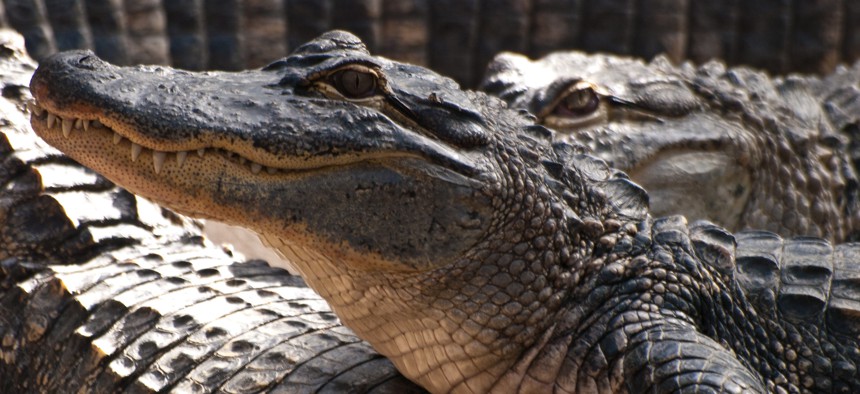
Alligators at Alligator Bay, Beauvoir, France William Warby
President Donald Trump yet again has proven the so-called experts wrong with his “out of the box” thinking — this time with a plan to defend America’s borders with a moat filled with snakes and alligators. In support of the president’s visionary agenda, the following memo lays out the projected costs.
Scale of Project: The length of the U.S.-Mexico border mandates a snake and alligator-filled ditch of 1,954 miles. The Canadian border would add an additional 5525 miles, but it is clearly not those kind of people that the president intended.
While portions of the moat could utilize the Rio Grande, that river’s flow rate and exit into the Gulf of Mexico would mean we would lose a substantial portion of the guard force (the snakes and alligators) within 7 to 10 days.
The exact required density of snake and alligators per mile for border security has never been tested. Given their speed and coverage capabilities, it would seem necessary to have a minimum of 10 alligators and 1,000 snakes per mile. Lower amounts may not create the desired deterrent effect towards any individuals and/or families seeking refuge in America.
Workforce Costs: While there is no General Services Administration standard for alligators, preliminary research indicates a unit cost of approximately $150 for hatchlings and $2,000 for adults. We may be able to supplement this with lower-cost alligators sourced from police auctions. (Another idea: a gator bounty could have a positive ancillary effect on “Florida Man” turnout for the 2020 election.) For planning purposes, we should assume an initial Alligator Border Guard force of 19,540 alligators, sustainably split between adults and hatchlings, for an initial buy of $21,005,500. At roughly $6.80 in shipping costs per pound, transportation costs will require another roughly $40,447,800.
Related: CBP Wants Technology To Spot Everything Crossing the US Border
Related: Border Patrol Wants Robots that Can Go Underground and Report Back
Related: US to Deploy Anti-Drone Defenses Along US-Mexico Border
For the 1,954,000-member Snake Border Guard, the optimal force laydown should mix water moccasins (for maximum water effectiveness) and brightly colored coral snakes (for maximum visual deterrence). The present price per snake is approximately $350, generating a cost of $683,900,000. Unfortunately, snakes have a limited life span, meaning after the initial purchase, we will have to pay this same fee seven years from now. But that is a problem to be solved by another president, hopefully Ivanka.
Additional Cost Elements: One challenge of adding a dangerous animal-based border guard is that it introduces three additional cost elements. Snakes and alligators do not require a salary, but do require food. There is an argument that our new guard force will be able to subsist on the flesh of illegal immigrants, but there is no guarantee that we will have the proper distribution of family members of sufficient size and weight (especially problematic are the small children) to sustain the new border system.
Therefore, we should plan that each member of the Alligator Border Guard unit will require roughly 300 pounds of food a year. Gator food pellets price at approximately $13 per pound, costing $76,206,000 per year. The snakes can exist on smaller amounts of food. Frozen rats come in at roughly $149 per pack (available on Amazon, but not Amazon Prime, so we’ll have to wait a week), yielding a cost of $291,146,000 each year.
Unfortunately, for all its experience at holding children in cages, U.S. Immigration and Customs Enforcement, or ICE, is not trained or equipped to maintain so many animals in cages. Care for the snake and alligator force will require at least one specialist per mile. Presently, the average starting salary of a zoologist is $38,212, which, adding in expected costs and benefits, comes to $130,665,934 per year.
Finally is the ever problematic health care issue, for which Obama is to blame. While many prospective illegal immigrants will be deterred by the snake-and-alligator moat, we should expect that the level of violence that they are fleeing and the prospect of joining the American dream will still induce some of the tired, poor, and yearning to be free to test the defense, even when faced by the prospect of death by bite or venom.
Each month there are roughly, 76,000 unauthorized border crossings. We can conservatively estimate that 10 percent might still try to make it. While the Alligator Border Guard likely will kill or at least maim any man, woman, or child, snake venom does not act immediately. Unfortunately, the liberal elite will likely force us to treat these wounded illegal immigrants before returning them to their homeland. Assuming another 10 percent are wounded, the $143,000 costs of treating venomous events yields an additional $1,304,160,000.
Summary: The sum total of President Trump’s Snake and Alligator Border Guard comes in at a highly reasonable cost of roughly $2.5 billion in set-up costs, plus annual operating costs of $1.8 billion.
This budget estimate, of course, does not include the cost of building the actual moat into which the guard force would be deployed. Here we can draw upon the past precedent of diverting $3.6 billion from the U.S. military construction budgets towards border wall repairs. While there has not been a single terrorist attack over the last 15 years linked to illegal immigrants, we can make the case that the alligator and snake moat is a far better national security investment than new military housing for our troops, repairs of base schools for their families, or training ranges and command and control facilities to allow them to win any future wars.
In conclusion, the multi-billion dollar costs of a snake-and-alligator filled moat along the U.S. border are a major commitment. But what better way to show President Trump’s own commitment to American values than by putting tens of thousands of dangerous animals right alongside its citizens?
P.W. Singer is strategist at New America and author of LikeWar: The Weaponization of Social Media…and this is obviously a parody.




